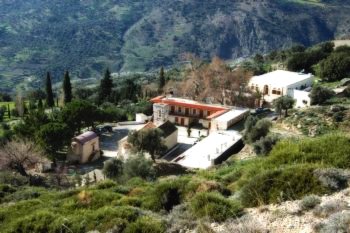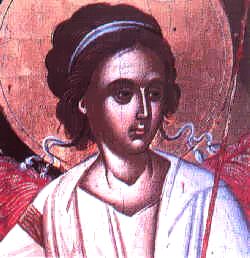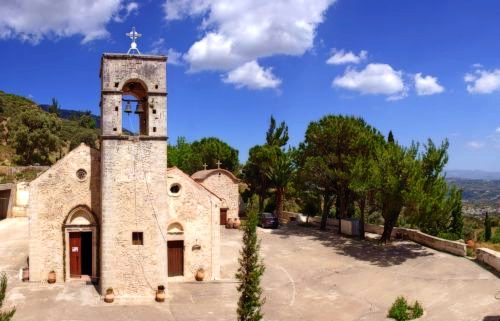
The Vrontisiou Monastery (GR: Μονή Βροντησίου), lies 50 kilometres away from Heraklion, on the south slope of the Psiloritis Mountain, a little to the north-west of the
town of Zaros. It is not known when exactly the monastery was founded and by whom, but it is generally believed that it was founded during the Second Byzantine Period (tenth to thirteenth centuries).
This is one of Crete's most famous monasteries.It played an important role during the years of the Cretan Renaissance, both in the letters and the arts, and, during the last centuries of Venetian rule, it was known for its many scholars, artists and venerable monks.

The names of famous manuscript copyists, painters and teachers are linked to the monastery and its surroundings.
Michalis Damaskinos, Crete's most important Byzantine artist, painted here six of his masterpieces, and, according to tradition,
El Greco himself spent some time as a student in the monastery's workshops.
Vrontisiou Monastery reaches its highest cultural development under the Venetians. The Turkish invasion in 1669 marks the beginning of its decline and the monastery is violently attacked by the Turks during the periods of Cretan rebellion.
In spite of the fact that the walls of the monastery are practically completely destroyed,
they still retain their fortress look and the church stands in the middle, with its double nave dedicated to Saint Anthony and to the Apostle Saint Thomas .
The present-day entrance to the monastery is new, but one can still distinguish the old one with its impressive central arch.
The bell-tower is independent from the church and bears the influence of the catholic style of the time. In the interior of the church, along the walls of the double nave, some of the remarkable wall paintings are still visible: among them, the one showing Saint Simeon Theodochos holding the Holy Child is outstanding. Equally remarkable, among the many interesting paintings on the iconostasis, is the representation of the Vine by the artist Angelos, one of the most famous paintings of the Cretan School.

The fountain
Outside the monastery walls, under everlasting plane-trees, there is a beautiful fountain, one of the island's most important outdoor sculptures, a unique heirloom of its time. It represents Adam and Eve in relief and water pours out from the mouths of four figures representing the rivers of Edem. |
|
The disasters that hit the monastery, particularly in the 19th century, have destroyed a vast number of relics, leaving us only enough to realise the great role it played as one of leading centres during the Cretan Renaissance.